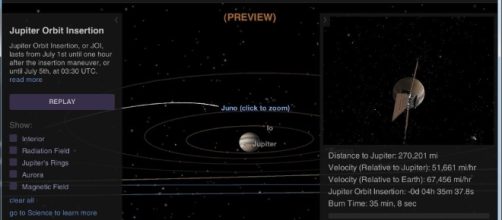Today, Sunday December 11, 2016, marks the third time that Juno spacecraft will flyby Jupiter. At the time of closest approach-perijove, Juno will have reached an altitude of about 4,150 km (2,580 miles) above Jupiter´s dense clouds. The seven science instruments that form part of Juno´s instruments will be turned on to conduct scientific data collection. During this flyby, the entire Juno´s capabilities will be utilized to study Jupiter´s gravity field, revealing the nature of its interior structure.
Juno´s orbital period
Juno was supposed to enter in an orbital period of 14 days on October the 19th; however, a malfunction on a valve, the manoeuvre was postponed for December the 11th.
On this date, the orbital insertion of 14 days is still being considered as the spacecraft has been performing well and the mission team does not want to add unneeded risks. To date, Juno has approached Jupiter three times, on each close bypass the spacecraft has gathered data from the giant planet; however, this December 11th flyby, Juno will be measuring the planets gravity field, revealing father first time the structure of Jupiter´s deep interior.
Juno´s mission
Juno spacecraft was launched from Cape Canaveral on august 5, 2011 and arrived on Jupiter´s whereabouts on July 4, 2016. Juno´s main mission is to study Jupiter’s atmosphere; its composition and structure. It will also study the planet´s magnetic and gravity fields; its magnetosphere and auroras to allow scientists to learn about Jupiter´s powerful magnetic field.
Overall, the study will allow the understanding of the origins of the solar system and the origin and evolution of the gads giant planet.
Apple iBook
In collaboration with Apple Inc., NASA will make available to the public an interactive book of this mission. The iBook will be released on December 11th, 2016.
During tomorrow´s- December 11th, 2016´s Jupiter flyby, Juno will be travelling at an approximate speed of 57, 8 km p/s (129,000 miles/h). Only seven of its eight science instruments will be collecting data, except from the Jovian Infrared Aurora Mapper (JIRAM), which will undergo an update to its software; however, JIRAM is expected to be functional on the next February 2, 2917 perijove.

